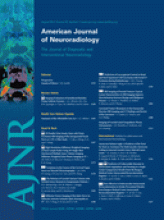We thank Alfieri, Prell, and Fleischhammer for their very careful reading of our work1 and their thoughtful comments.
Before replying to the matter of concern stated by Alfieri and colleagues, we first would like to emphasize that neither is there a causal relationship between our study of identification of the nervus intermedius (NI) by using 3T MR imaging and the question of how the parotid gland is innervated nor are the results of our study negatively influenced or called into question by this concern.
We agree with Alfieri and colleagues that there is no proof so far that the NI in humans directly innervates the parotid gland.
However, to provide an indemnification for this erroneous mention of the parotid gland, we suggest thinking about whether there might be implications for an indirect or even direct innervation because we also agree with Alfieri et al that “not all features are well known and the common definition as a purely sensory and parasympathetic root of the facial nerve may not cover all aspects of the nervus intermedius.”2
Alfieri and colleagues stated that it has been generally accepted that the parasympathetic innervation of the parotid gland originates in the inferior salivary nucleus—as in most mammals. We agree with this general acceptance, though we think that the lack of clarity should be corrected before the glossopharyngeal nerve is claimed to be exclusively responsible for parotid gland innervation in humans.
To the best of our knowledge, the precise location of the inferior salivatory nucleus (separated from the superior salivatory nucleus) in adult humans has not yet been identified.3 Therefore, regarding the efferent innervation, future research should evaluate to what extent the inferior (nervus glossopharyngeus) and superior salivary neurons (NI) intermingle, interact, or even form a common or inhomogeneous salivary area as was found in the rat.4
Furthermore, a secretory role for the facial nerve was described in other mammals such as the rat.5 In addition, Porto et al6 reported on failures of Jacobson's nerve resection to eliminate parotid secretion in clinical cases. That finding suggests that an alternative secretory route to the parotid gland exists. They state that only the facial nerve carries accessory efferent fibers to the gland in the cat.6
In our clinical experience, resection of the glossopharyngeal nerve in humans also does not invariably lead to a complete termination of saliva production in the parotid gland.
Finally, we like to refer to the interconnections of the facial, intermediate, and glossopharyngeal nerves (Figs 2–24, eg, the lesser petrosal nerve) described by May and Schaitkin.7 These interconnections are not conclusively evaluated in humans.
References
- Copyright © American Society of Neuroradiology












